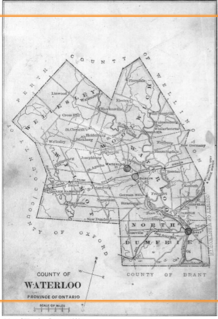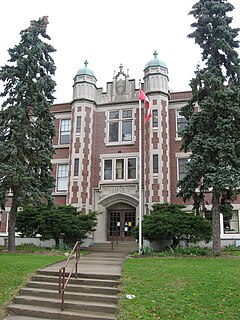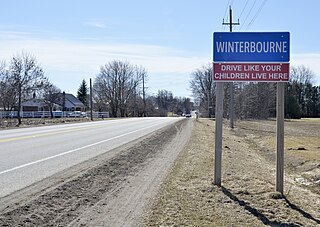
Waterloo is a city in the Canadian province of Ontario. It is one of three cities in the Regional Municipality of Waterloo. Waterloo is situated about 94 km (58 mi) southwest of Toronto. Due to the close proximity of the city of Kitchener to Waterloo, the two together are often referred to as "Kitchener–Waterloo" or the "Twin Cities".

Kitchener is a city in the Canadian province of Ontario, about 100 km (62 mi) west of Toronto. It is one of three cities that make up the Regional Municipality of Waterloo and is the regional seat. Kitchener was known as Berlin until a 1916 referendum changed its name. The city covers an area of 136.86 km2, and had a population of 256,885 at the time of the 2021 Canadian census.

Cambridge is a city in the Regional Municipality of Waterloo, Ontario, Canada, located at the confluence of the Grand and Speed rivers. The city had a population of 138,479 as of the 2021 census. Along with Kitchener and Waterloo, Cambridge is one of the three core cities of Canada's tenth-largest metropolitan area.

The Regional Municipality of Waterloo is a metropolitan area of Southern Ontario, Canada. It contains the cities of Cambridge, Kitchener and Waterloo, and the townships of North Dumfries, Wellesley, Wilmot and Woolwich. Kitchener, the largest city, is the seat of government.

Waterloo County, created in 1853 and dissolved in 1973, was the forerunner of the Regional Municipality of Waterloo in Ontario, Canada. Situated on a subset of land within the Haldimand Tract, the traditional territory of the Attawandaron, Anishinaabe and Haudenosaunee peoples, Waterloo County consisted of five townships: Woolwich, Wellesley, Wilmot, Waterloo, and North Dumfries. The major population centres were Waterloo, Kitchener, Preston, Hespeler, Blair, and Doon in Waterloo township; Galt in North Dumfries; Elmira in Woolwich; and New Hamburg in Wilmot. All are now part of the Regional Municipality.

St. Jacobs is a community and former village located in the township of Woolwich in Waterloo Region, Ontario, just north of the city of Waterloo. It is a popular location for tourism, due to its quaint village appearance, retail focus and Mennonite heritage. Waterloo Region is still home to the largest population of Old Order Mennonites in Canada, particularly in the areas around St Jacobs and Elmira. They are often seen on the local roads using their traditional horse and buggy transportation; many also use horses to pull the implements in their farm fields.
St. Jerome's University, commonly shortened to St. Jerome's or SJU, is a public Roman Catholic university in Waterloo, Ontario. It is federated with the University of Waterloo. St. Jerome's, within the University of Waterloo, combines academics and a residence. Students may both reside at and take classes through St. Jerome's, live at SJU in residence but take classes elsewhere, or live in another residence but take classes at St. Jerome's.

Fergus is the largest community in Centre Wellington, a township within Wellington County in Ontario, Canada. It lies on the Grand River about 18 km NNW of Guelph. The population of this community at the time of the 2016 Census was 20,767, but the community is growing as new homes are being built for sale.

Kitchener-Waterloo Collegiate and Vocational School, commonly called Kitchener Collegiate Institute or KCI, is a public secondary school in Kitchener, Ontario, Canada. It is a member of the Waterloo Region District School Board. The school dates from 1855, making it one of the oldest high schools in Kitchener and Waterloo. Its sports teams are known as the Raiders.

The Seagram Museum was a museum in Waterloo, Ontario, Canada, preserving the heritage of the once venerable Canadian distillery Seagram. Located at 57 Erb Street West, the museum operated from May 1984 to March 1997. Designed by architect Barton Myers, it was built at a cost of $4.75 million and its entrance was a renovated late-19th century rack warehouse from the Seagram plant. It had a variety of exhibits illustrating everyday life in the liquor distillery in the late 19th and early 20th century.

Elizabeth Ziegler Public School is an elementary school located in Waterloo, Ontario, at 90 Moore Avenue South, roughly one kilometre east of Waterloo's city centre. As of 2009, the school serves junior kindergarten through grade 6. Its principal is currently Ms. Susan Marchiori, and it has a vice principal, Ms. MacNeill. The school also currently hosts one mixed grade 5&6 enrichment class for gifted students. In 2005 the school was ranked 971st out of 2,850 elementary schools in Ontario by the Fraser Institute, based on the results of grade 3 and 6 students on province-wide standardized tests.

Winterbourne is a village located to the east of the Grand River in the township of Woolwich in the Regional Municipality of Waterloo, Ontario, Canada. It is located just northeast of the city of Waterloo. The fine stonework of the Scottish stonemasons can be seen in many of the older buildings throughout the settlement.

Abraham Erb, sometimes called the founder of Waterloo, Ontario, was the first Mennonite settler from Pennsylvania. His brother John is considered the founder of the Preston community in Cambridge, Ontario. Abraham offered help to many immigrants from his native Pennsylvania area through the means of education, shelter, and employment as they chose to move from the United States to Upper Canada. He was married to Magdaena and had one biological child, who died at the age of seven, and two adoptive children. His adopted son was named Barnabas, a noted land speculator.
Jacob Yost Shantz was a Mennonite farmer, businessman, and industrialist from Ontario, Canada. He played a significant role in the urban development of Berlin, Ontario, where he held a succession of civic roles over a period of almost three decades, culminating in a term as mayor in 1882. Over the span of his life, Berlin was transformed from a rural agricultural settlement known as Ebytown into a bustling manufacturing centre; this was a change mirrored by Shantz, who began his adult life as a farmer and sawmiller, and ended it as a prominent local industrialist.

Doon is a suburban community and former village which is now a part of the city of Kitchener, Ontario, Canada. Doon was settled around 1800 by German Mennonites from Pennsylvania, and after 1830 by Scottish immigrants. The area is located at the confluence of Schneider Creek and the Grand River. The post office was opened in 1845. A large flour mill, oatmeal mill, distillery and sawmill were built on the Doon River over the following years. The Perine brothers established extensive linen works and flax mills near the settlement. By 1870, there was a single church, Presbyterian, a variety of tradesmen and a population of 200.
Christian Kumpf was a German-born politician in Ontario, Canada. He served as mayor of Waterloo from 1879 to 1880 and from 1888 to 1889.

Waterloo Park is an urban park situated in Waterloo, Ontario, Canada on land within Block 2 of the Haldimand Tract. Spanning 111 acres within the Uptown area of Waterloo, it opened in 1893 and is the oldest park in the city. Managed by the City of Waterloo, the park contains numerous recreational amenities including athletic fields, baseball diamonds, playgrounds, a skateboard park, and the Laurel and Trans Canada trails.

Brubacher House is a historic house museum in Waterloo, Ontario, Canada which showcases the home life of 19th century Mennonite pioneers in Waterloo County. The house was built in 1850 or 1851 by the Mennonite community for the Brubacher family. It and its attached farmland were sold in 1965 to the University of Waterloo.
















